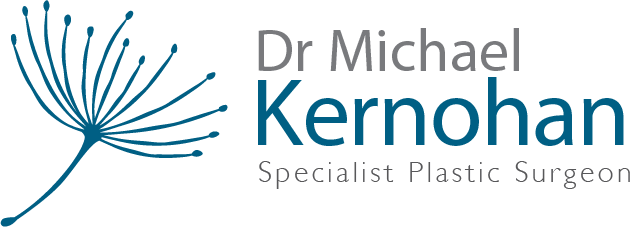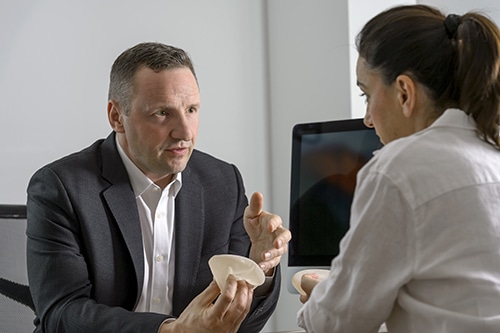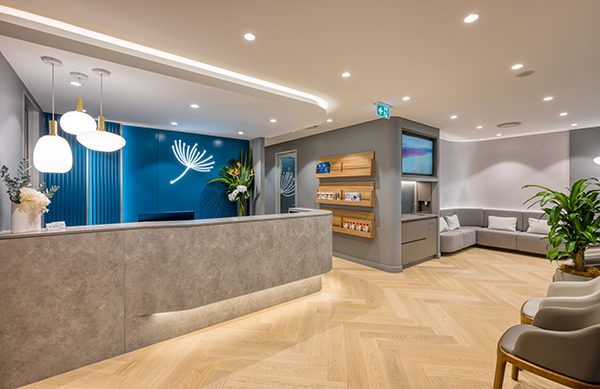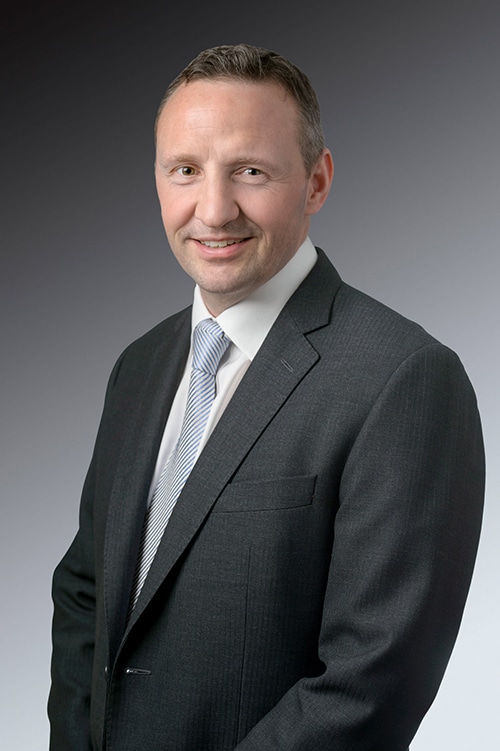Breast Explant Surgery – Myths, Facts, Options
After making the decision to remove breast implants, some might be wondering what happens next and what will the breasts look like after breast explant surgery. In this blog, Sydney Specialist Plastic Surgeon Dr Michael Kernohan will discuss myths, facts and options after breast implant removal surgery.
Take the Quiz
Debunking Myths & Managing Expectations
The decision to remove breast implants can come with a wave of relief, but it can also stir up anxieties about the unknown. What will my breasts actually look like? Will I be happy with the results? It’s easy to get caught up in myths and misconceptions, so let’s set the record straight and cultivate realistic expectations about the explant journey.
Myth 1: My Breasts Will Go Back to Exactly How They Were Before Implants.
This is perhaps the biggest misconception surrounding explant. While some women experience a degree of resemblance to their pre-implant shape, expecting an identical reversal is unrealistic. Why? Because breast implants, regardless of type or placement, inevitably alter the body’s natural landscape.
- Skin Stretching: Imagine a balloon expanding and contracting. Skin, while remarkably elastic, has its limits. Implants, especially larger ones, stretch the skin over time. Upon removal, the skin may not fully retract to its original state, potentially leading to some degree of looseness.
- Tissue Atrophy: In some cases, the breast tissue itself can thin or shrink (atrophy) after prolonged implant presence. This happens because the implants essentially “do the work” of supporting the breast shape, causing the underlying tissue to become less robust.
- Genetics Play a Role: Just as our natural breast size and shape are influenced by genetics, so too is our skin’s elasticity and our body’s capacity for tissue regeneration. Some individuals are genetically predisposed to greater skin elasticity, while others may naturally have less.
Myth 2: All Explanted Breasts Look Deflated and Saggy.
This myth is particularly damaging, often fuelled by carefully curated “before & after” photos that don’t represent the full spectrum of explant experiences. While some degree of deflation and sagging is possible, it’s far from universal.
The degree of deflation and sagging depends on a myriad of factors, including:
- Implant Size & Placement: Larger implants and those placed under the muscle (submuscular) tend to cause more stretching, potentially leading to greater laxity after removal.
- Individual Skin Elasticity: As discussed earlier, genetics play a role in how well the skin retracts.
- Surgeon’s Skill: Explant surgery is not a one-size-fits-all procedure. A skilled and experienced surgeon can make a significant difference in minimising skin laxity and optimising the final aesthetic.



Factors Influencing Post-Explant Appearance
While the internet is filled with “before & after” photos showcasing explant results, it’s important to approach these images with a critical eye. They offer a glimpse into possibilities, not guarantees. The truth is, predicting the exact outcome of explant is like trying to solve a complex equation with countless variables. Let’s break down the main factors at play:
- Limited Representation: “Before & after” photos often showcase ideal cases, carefully selected to demonstrate dramatic transformations. They rarely capture the full spectrum of experiences, leaving many women feeling like their results are “abnormal” if they don’t align with these curated images.
- Individual Variation: Just as no two bodies are alike, no two explant journeys are identical. Factors like genetics, lifestyle, and surgical techniques create a unique tapestry of outcomes.
- The Power of Perspective: The same post-explant photo can evoke vastly different emotions in different women. What one woman perceives as “deflated,” another might view as “natural” and liberating. Our perception of beauty is deeply personal and constantly evolving.
Individual Factors
- Age & Genetics: Just as our skin’s natural elasticity declines with age, so too does its ability to bounce back after implant removal. Genetics also play a significant role in determining skin thickness, collagen production, and overall tissue resilience.
- Pre-Implant Canvas: Your starting point matters. Women with naturally larger, denser breasts may experience less noticeable changes than those with smaller breasts. Similarly, the shape of your ribcage and the distribution of breast tissue pre-implant can influence the final outcome.
- Implant History: The type, size, placement, and duration of implant placement all contribute to the degree of tissue stretching and potential atrophy. Larger implants, submuscular placement (under the muscle), and prolonged implant duration tend to have a more pronounced impact on the surrounding tissues.
- Pregnancy & Breastfeeding: Pregnancy itself stretches the breast tissue, and hormonal fluctuations can further impact skin elasticity. While some women experience a “return to normal” after breastfeeding, others may notice lasting changes in breast shape and size.
Surgical Factors
- Surgeon’s Expertise: Explant surgery is not a one-size-fits-all procedure. Finding a plastic surgeon with extensive experience in both explant and breast reconstruction is important. They can assess your individual anatomy, understand your goals, and tailor the surgical approach accordingly.
- Techniques & Capsulectomy: The techniques used for implant removal and the decision to perform a capsulectomy (removal of the scar tissue capsule that forms around the implant) can significantly impact the final aesthetic. A skilled surgeon will prioritise minimising scarring, preserving healthy tissue, and optimising breast shape.
- Reconstruction Options: For women seeking to address volume loss or sagging after explant, various reconstruction options exist, including fat grafting (transferring fat from other areas of the body) and breast lift (mastopexy). The choice of technique depends on individual goals, anatomy, and surgeon’s recommendations.
Download Dr Kernohan’s Cosmetic Breast Ultimate Guide

Fat Grafting: A Natural Approach to Restoring Volume
For women seeking a more natural approach after explant, fat grafting emerges as a compelling option. This technique, also known as autologous fat transfer, harnesses the body’s own resources, utilising your fat cells to restore volume, refine contours, and create a softer, more natural aesthetic compared to traditional implants.
One of the most appealing aspects of fat grafting is its reliance on your own body’s building blocks. Here’s how it works:
- Harvesting: Using liposuction techniques, fat is gently extracted from donor areas where you have excess fat deposits, such as the abdomen, thighs, flanks, or back.
- Processing: The harvested fat undergoes a purification process to remove impurities and isolate healthy, viable fat cells.
- Injection: The purified fat is strategically injected into the breasts using specialised cannulas (thin tubes), carefully layering and sculpting the fat to achieve the desired volume and shape.
This use of your own tissues minimises the risk of rejection or allergic reactions, a significant advantage for women who may have experienced complications with implants.
Concerns: Unevenness, Multiple Procedures, and Fat Absorption
While fat grafting offers numerous benefits, it’s essential to address common concerns:
- Unevenness: Achieving perfectly symmetrical results with fat grafting can be challenging, as fat absorption rates vary from person to person. Uneven fat distribution can lead to contour irregularities, requiring touch-up procedures to refine the final aesthetic.
- Multiple Procedures: Because the body naturally absorbs a portion of the transferred fat (typically 20-30%), achieving the desired volume often requires multiple grafting sessions, spaced several months apart. This staged approach allows for gradual volume restoration and minimises the risk of complications.
- Fat Absorption Rates: Individual factors such as metabolism, lifestyle, and the area of fat harvest can influence fat absorption rates. Dr Kernohan will discuss these factors and provide realistic expectations about the number of sessions required to achieve your goals.
Mastopexy after Breast Explant
While often associated with addressing age-related sagging, a breast lift, or mastopexy, can play a role in the post-explant journey, particularly for women grappling with deflated or misshapen breasts. Contrary to common assumptions, a lift doesn’t necessarily involve adding volume. Instead, it focuses on reshaping and repositioning existing breast tissue.
Here’s how it works:
- Incisions and Excess Skin Removal: Depending on the degree of sagging and desired lift, incisions are strategically placed around the areola, vertically down from the areola, or along the breast crease. Through these incisions, excess skin is carefully removed.
- Breast Tissue Repositioning: The underlying breast tissue is then lifted and reshaped. The areola, often stretched by implants, may also be resized and repositioned.
- Suturing and Closure: Dissolvable sutures are used to close the incisions and support the newly lifted breast shape.
While a mastopexy can significantly alter the appearance of deflated breasts after explant, it’s important to approach the procedure with realistic expectations.
- Not a Return to Pre-Implant: A lift cannot erase the history of implant placement or restore your breasts to their exact pre-implant state. Skin elasticity, tissue atrophy, and individual healing capacities all influence the final outcome.
- Scars are Part of the Process: Like any surgical procedure, mastopexy involves incisions and, consequently, scars. While skilled surgeons prioritise minimising scarring, it’s essential to understand that scars are a natural part of the healing process.
Combining Fat Grafting and Mastopexy
For women seeking both lift and volume restoration, combining a mastopexy with fat grafting offers a comprehensive approach. The fat grafting can address volume deficits, while the lift refines the shape, creating a more harmonious and natural-looking result.
FAQs about Breasts after Removing Breast Implants

Will my nipples look different after explant?
- Yes, it’s possible. Implants can stretch the areola (the pigmented area around the nipple) and displace the nipple itself. After explant, nipples may appear smaller, larger, or sit higher or lower than before. Some women find their nipples become more sensitive or less so. During a lift or reconstruction, nipple position and size can often be adjusted for a more balanced look.
What about stretch marks – will explant make them worse?
- Explant itself doesn’t directly worsen stretch marks, but they may become more noticeable if the skin surrounding them loses volume and sags. Existing stretch marks won’t disappear, but their prominence varies based on skin elasticity, implant size, and how long they were in place.
I have capsular contracture. Will my breasts look more natural after removing those capsules?
- Capsular contracture, where scar tissue tightens around the implant, can distort breast shape. While explant with capsulectomy (capsule removal) often improves symmetry and natural feel, it doesn’t guarantee a perfect pre-implant look. The capsule’s constriction can leave lasting effects on breast tissue.
How soon after explant will I see my “final” breast appearance?
- Patience is key! Initial swelling subsides within weeks, but it can take 6-12 months (or longer) for tissues to fully settle and for the final outcome to emerge. Factors like skin elasticity, age, and whether additional procedures are done (lift, grafting) impact this timeline.
I’m worried about loose skin after explant. Are there non-surgical options to improve this?
While surgery offers the most dramatic changes for loose skin, non-surgical options exist to help manage the appearance:
- Supportive Bras: Specially designed bras for post-explant or post-mastectomy can provide lift and shaping.
- Topical Creams: While not a miracle cure, creams containing retinol or hyaluronic acid may improve skin elasticity over time.
- Healthy Lifestyle: Maintaining a healthy weight, eating a nutrient-rich diet, and staying hydrated can promote skin health.
Further Reading about Breast Surgery with Dr Michael Kernohan
- Read more about Should I Have a Breast Lift or Breast Implants?
- Read more about Can Your Breasts Grow Back After Breast Reduction Surgery?
- Read more about How Can I Enlarge My Breasts?
- Read more about What Is Breast Explantation?
- Read more about Breast Reconstruction Sydney
- Read more about What Will My Breasts Look Like after Removing My Breast Implants?
Medical References about Breast Implant Removal
- What Can We Learn from Breast Implant Explantation – NCBI
- Breast Implant Removal: What to Expect, Surgery & Recovery – Cleveland Clinic
- Imaging Features Following Breast Explant Surgery – NCBI
- Explantation and Mastopexy: The Vertical Mammaplasty Technique to Optimize Breast Shape – Oxford Academic
- Breast implant removal: Procedure, cost, and more – Medical News Today







